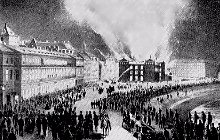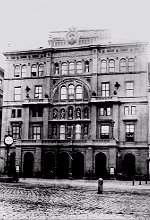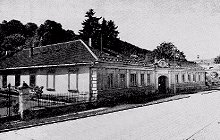| [naar
inhoudsoverzicht muziekgeschiedenis]
[naar
inhoudsoverzicht korte biografieen]
[terug naar inhoud
Suppe-biografie]
[naar
literatuurlijst]
inhoud:
|
BIOGRAPHY second part (1860-1895)
Suppé at the Theater am Franz-Josefs-Kai

The great fire at the theatre 1863
While the conductor of the Theater an der Wien became more and more
popular, the director Alois Pokorny had to file a petition in bankruptcy
for the house in spring 1862. Suppé had to look out for both
a new occupation and a new lodging. He accepted finally Karl Treumann's
offer to become conductor at the Theater am Franz-Josefs-Kai and moved
to the Obere Donaustraße 57.
The actor and singer Karl Treumann had already cooperated
with Suppé at the Theater an der Wien, but then he went to the Carltheater
and founded finally his own theater: He raised at the Franz-Josefs-Kai
- near today's Morzinplatz - a new building, which was inaugurated on November
1st 1860. Especially Offenbach's vaudevilles and farces with vocal
numbers were presented here to the Viennese public.
The theater, also called „Treumann-Theater" by the Viennese -
besides Karl Treumann his brother Franz and his sister-in-law Therese worked
there -, enjoyed great popularity with the Viennese people.
But Suppé's work at this theater ended abruptly. On the
night of June 9th 1863, a fire broke out after the performance and
the building burned to the ground. But for Treumann that was a blessing
in disguise. Shortly after, he had the opportunity of leasing the traditionalistic
Carltheater in the second district. Director and conductor started now
their new jobs at the theater at Praterstraße.
The operetta „Zehn Mädchen und kein Mann"
On April 1st 1862, Suppé made his debut at the Theater am
Franz-Josefs-Kai both as conductor and as composer with the première
of the new operetta „Die Kartenschlägerin". Treumann
had translated the French text by an anonymous author into German. But
the play was denied the success. Shortly after, Treumann presented a new
text to his conductor: „Zehn Mädchen und kein Mann" was performed
on October 25th 1862 at the theater at Morzinplatz.
The story: A father of ten girls is despairing, because
none of the girls is married. When a young man appears finally, he makes
them sing and dance one after the other in front of the potential husband.
But finally he hears the name of the youth and it turns out that he is
his son, of whose existence he was not aware. The young man wants to marry
the parlormaid - and the father has now eleven children...
The dances and songs of the operetta (such as a „Tyrolienne" and
an Italian „Arietta") remodeled on the folkloric music of different parts
of Europe - therefore, the work enjoyed great popularity and became soon
a repertory play. A few years later, Suppé composed several new
interludes on the occasion of a performance for the benefit of the Emperor
Franz Josef foundation at the court opera (April 15th 1873).
„Flotte Bursche"
Suppé's greatest success at the Theater am Franz-Josefs-Kai was
„Flotte
Bursche". On the occasion of the first performance on April 18th
1863, the public joined already in the singing of the overture, which
was composed of well-known German student songs. The piece was repeated
twenty times.
The story: Students of Heidelberg try to help the unfortunate
courting couple Anton and Lieschen. They want to get married, but they
are short of the necessary money. By dint of a ruse, the students ease
Lieschen's rich and miserly guardian of a hefty sum, they give to the couple.
Now, there is nothing to prevent their bliss.
The Carltheater

Its first director Marinelli built the former theater in the Leopoldstadt
in 1781. Contrary to the court theaters, local and magic farces,
plays of robbers and soldiers, parodies and Singspiels were performed here
above all. It was the favorite theater of the Viennese people for many
years. Many famous actors and playwrights worked for this stage - among
others Ferdinand Raimund, Therese Krones and Johann Nestroy.
In 1838, the actor Carl Carl purchased the theater. He pulled
down the old building in 1847. After a time of construction of eight
months, the Carltheater was inaugurated in December 1847. From 1854
to 1860, Johann Nestroy managed the theater. Many of his
plays were performed for the first time here.
Suppé at the Carltheater
On March 5th 1864, Suppé's comic operetta „Das Corps der
Rache" was performed at the Carltheater. After the tenth performance,
the play was taken off the program. Only a „Pas Espagnol" with about
45 actors was played time and again even later.
„Die schöne Galathee"
After some less noteworthy compositions by Suppé, „Die schöne
Galathee" was performed for the first time on September 9th 1865
- this operetta would become one of his greatest successes.
The story: Pygmalion falls in love with the marvelous statue
of Galathee. Aphrodite fulfills his wish and breathes life into the statue.
Whereas Galathee causes only mischief and flirts too frivolously with several
men at the same time, Pygmalion asks the goddess for changing back the
beautiful Galathee into a statue. The Viennese public applauded enthusiastically
- the ironical treatment of mythological texts was in vogue after Offenbach's
success with the „Schöne Helena".
„Leichte Kavallerie"
On March 21st 1866, „Leichte Kavallerie" (libretto by Carl
Costa) was performed for the first time at the Carltheater. The overture
became world-famous. It is Suppé's most popular composition till
today.
The story: Hussars are billeted in an Hungarian village.
One of them, Hermann, falls in love with Vilma, the most beautiful girl
of the village, and she returns his love. But Vilma has many admirers:
The influential men of the village are against their marriage by jealousy.
But they fall a prey to a clever intrigue and have to give willy-nilly
their consent to the marriage finally.
Since his twentieth birthday, Suppé composed continuously
music for the stage. Over forty years old, he composed his first operettas,
„Die
schöne Galathee" stands out from them, and after many other more
or less successful plays he did only in late years the jobs of his life
with „Fatinitza", „Donna Juanita" and „Boccaccio", which
can be regarded as his masterwork.
All three works are based on librettos by the successful authors
Zell
and Genée. „F. Zell" was the pen name of Camillo Walzel
(1829-1895), who came from Magdeburg and worked as feuilletonist and
librettist in Vienna since 1847. Richard Genée (1823-1895),
born in Danzig (Gdansk), was a composer, conductor and librettist. From
1868
to 1878, he worked as conductor at the Theater an der Wien. The
two men wrote together the most famous librettos of the classical Viennese
operetta. „Die Fledermaus" and „Cagliostro in Wien" by Johann
Strauss as well as „Der Bettelstudent" by Karl Millöcker
were composed after their texts.
„Fatinitza"
On January 5th 1876, „Fatinitza" was performed for the first
time at the Carltheater and had immediately a rum of thirty consecutive
performances. The operetta had its 100th performance on January 31st
1878.
The story: The young lieutenant Wladimir participates in the
siege of the Turkish fortress Isaktscha by the Russian army. Some time
before, as he looked for love affair with a married lady, he had dressed
himself up as lady's maid Fatinitza - at that time, General Kantschukoff
met Fatinitza and fell in love with her. As, during the siege, the Russian
soldiers rehearse a stage play to kill time, Wladimir plays a woman's role
- Kantschukoff recognizes his beloved Fatinitza again. In the meantime,
the niece of the general, Lydia, arrives in the camp and Wladimir, dressed
up as lady's maid, falls in love with her. The general wants to get Lydia
and Fatinitza to safety, because the situation becomes dangerous, but they
are captured by the Turks during the journey. The Turkish commander Izzet
Pascha falls in love with Lydia too and wants to marry her. Shortly before
the marriage, Wladimir makes himself known to Lydia and avows her his love.
During the wedding, the Russians enter by force and liberate Lydia. In
the meantime, Fatinitza has put on Wladimir's uniform again. General Kantschukoff
is informed that Fatinitza has been abducted. Now, Wladimir gives himself
out to be Fatinitza's brother and accepts to consent to a marriage of his
sister with the general, if he is allowed to marry Lydia. The alleged Fatinitza
is produced, but turns out to be an ugly black. She presents to the disappointed
general a farewell letter of Fatinitza, who is supposed to be deceased
longing for the general - there is nothing to prevent the bliss of Wladimir
and Lydia...
„Boccaccio"
The next operetta „Boccaccio" surpassed by far the success of
„Fatinitza".
Its première was on February 1st 1879 at the Carltheater
and it was performed without a break till March 5th 1879.
The librettists Zell and Genée had stringed
some tales of Giovanni Boccaccio's famous novella collection Il Decamerone
together and put the poet himself in the center of the action.
The story: Boccaccio, author of the Decamerone, loves Fiametta,
the daughter of a duke. Despite many intrigues of his antagonist Pietro,
the prince of Palermo, they became finally man and wife.
„Donna Juanita"
On February 21st 1880, „Donna Juanita" was presented at
the Carltheater. The comedy „Die Verschwörung der Frauen oder die
Preußen in Breslau" by the dramatist Artur Müller from
Breslau (Wroclaw) serves as model for the librettists Zell and Genée.
They turned the Austro-Prussian war into a Franco-English war and shifted
the scene of the action to San Sebastian.
The story: The French cadet René Dufaure dresses
himself up as „Donna Juanita" to see how the land lies in San Sebastian
occupied by the English troops. During a festivity, where the children
are dressed up as adults and the adults are dressed up as children, the
French succeed in entering incognito the city and in vanquishing the English
army. The courageous Dufaure is promoted to lieutenant for his heroic deed.
Gars am Kamp - the „Sophienheim"

The Sophienheim
„Fatinitza" and „Boccaccio" were not only put on the stage
in Vienna - they were soon performed in all parts of Europe and even in
New York. His increasing fame brought Suppé invitations to the first
Bayreuth Festival (1876) and to Paris, Brussels, Germany and Italy (1879).
He got to know Florence, that he had never visited before, although he
grew up in Italy. The success made Suppé a well-off man.
In summer 1876, he followed his friends' advice to go on
a vacation in the Lower Austrian Kamp valley. He traveled to Eggenburg
and then to Gars am Kamp. As the countryside pleased him, he rented an
apartment at Haangasse 27. A marble tablet reminds still today, that Suppé
spent three summers (1876-1878) in this house and composed here parts of
his operetta „Boccaccio".

"Das Tor zum Sophienheim"
In 1879, he bought for 1,400 guldens the house Kremserstraße
40 and rearranged it. The former farmhouse was named „Sophienheim" after
Suppé's second wife. After the death of the composer, his study
was turned into a museum, where his handwritten works were kept for some
time, before they passed into possession of the municipal library of Vienna
and the Gesellschaft der Musikfreunde (society of music lovers) among others.
After an extensive renovation early in the seventies, the house serves
again as memorial place for Franz von Suppé.
The last years

Franz von Suppé
In summer 1882, at the age of sixty-three, Suppé gave
up his occupation as conductor at the Carltheater. He left the company
flat at the theater and moved to Kleinschmidgasse 1 at the 4th district.
In autumn 1883, he exchanged this apartment for another in the center
Laurenzerberg 5 and in November 1887 he moved to a spacious apartment
at Oprenring 23, where he lived till he died. His last finished operetta
was performed for the first time on March 17th 1883 at the Theater
an der Wien. In the same year, Suppé conducted the work successfully
in Germany.
The death of his son Peter in November 1891 hit Suppé
hard. The first signs of a serious illness became apparent. He continued
to compose, worked on his last operetta „Das Modell" and wrote several
religious works. But his health deteriorated rapidly. On April 18th
1895 he celebrated his 76th birthday in Vienna. He spent the next two
weeks in Gars, but returned to Vienna on May 3rd. Franz von Suppé
deceased on May 21st 1895, On May 23rd, the solemn consecration
took place at the Augustinerkirche. The choirs of the Carlstheater and
the Theater an der Wien sang Suppé's „Ruhe, müder Wanderer".
| A monument by the sculptor Josef Tautenhayn adorns his tomb of honor
at the central cemetery of Vienna (Zentralfriedhof, Ehrengrab Nr. 31, Gruppe
32A). Josef Tautenhayn. |
|
|
|
|
|
|

His tomb |
|